What is a drag screen in basketball
The drag screen consists of offensive action that occurs when a player in possession of the basketball receives a screen from another player, typically during secondary break of transition offense before the defense is fully prepared and organized.
Furthermore, the player without the ball, which is usually a power forward or center, rolls to the basket or pops to an open space near the perimeter after setting the screen.
Why is the drag screen a potentially effective action
The drag screen is a potentially effective action because the defensive team will usually not be able to implement an adequate amount of ball screen coverage to limit or prevent its efficacy.
More specifically, during transition offense, the defensive team will generally try to protect the basket, stop the ball with immediate on-ball pressure, and/or guard against three-point shooters.
Yet, as that occurs, the defensive team is generally not well prepared to defend against the on-ball screen, which in this case, is the drag screen.
Essentially, in a standard half court setting in which the defense is fully set and organized, the defensive team will have the ability to counter against the on-ball screen, typically with tactics such as the defensive hedge, ice defense or drop coverage.
However, during transition defense, it is much more difficult to implement those types of defensive tactics, either at all, or at least sufficiently.
What are examples of drag screen scoring options
Example 1

This is an example of a basic drag screen scoring option, which could occur during secondary break action.
To begin, 1 dribbles towards the right side of the court via the drag screen set by 5 who also rolls to the basket. Next, 5 can receive the ball from 1 and score near the basket.
Example 2

Here is an example of the basic drag screen with pop action. 1 dribbles toward the right side of the court via the drag screen set by 4.
Next, 4 pops to the top and receives the reversal pass from 1. After that, 4 can take the jump shot if open.
Example 3

This is an example of a double drag screen with a player that rolls to the basket and a player that pops to the top. 1 dribbles toward the right side slot area via the double drag screens set by 4 and 5.
Next, 5 rolls to the basket while 4 pops to the top. 4 could receive the ball for a perimeter shot or 5 could receive the ball and score with a layup or dunk near the rim.
Example 4
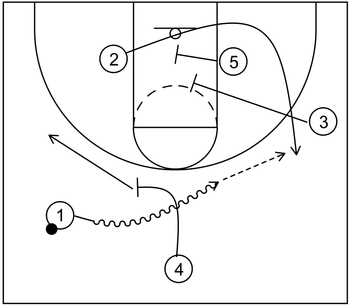
Here is an example of the drag screen action in addition to stagger screens. 1 dribbles toward the top and as that happens, 2 cuts to the right side wing via stagger screens set by 4 and 5.
Next, 2 receives the ball from 1 and could take the open jump shot.
Example 5
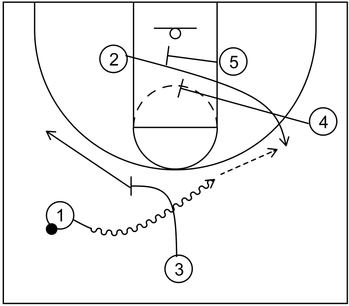
This is an example of the drag screen and elevator screens which could create a perimeter scoring opportunity. 1 dribbles to the top via the drag screen set by 3 who also pops out to the left side wing.
Also, as that action happens, 2 cuts to the right side wing via a pair of elevator screens set by 4 and 5. Following that, 2 could receive the ball from 1 and take the open jump shot.
Example 6
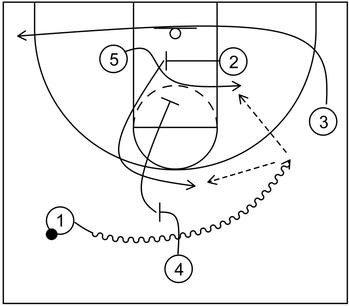
This example demonstrates a drag screen and screen the screener action. 1 dribbles to the right side wing via the drag screen set by 4.
At the same time, 3 cuts through to the left side corner while 5 cuts to the right side low post via the cross screen set by 2.
Next, 2 cuts to the top via the down screen (screen the screener action) set by 4. From this point, 5 could receive the ball and score with a low post move or 2 could receive the reversal pass and take the jump shot if open.
Example 7
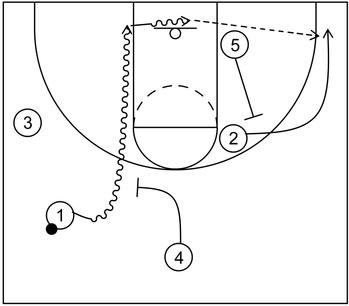
This is an example of ball screen rejection as well as hammer screen action to create a perimeter scoring opportunity. 1 rejects the drag screen set by 4 and begins to dribble towards the basket.
At the same time, 2 cuts to the right side corner via the back screen set by 5. Next, 2 receives the drift pass from 1 and then takes the open three-point shot.
Example 8
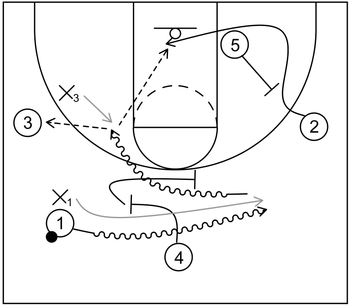
This is an example of drag screen twist and flex action to create scoring opportunities. 1 dribbles toward the right side slot via the drag screen set by 4.
However, X1 jumps over the top of the screen and is able to continue guarding 1, shown with the gray arrow. When this happens, 1 dribbles towards the left side via the twist drag screen (another re-screen) by 4.
Additionally, as the re-screen action occurs, 2 cuts to the basket via a wing flex screen set by 5. Next, 2 could receive the pass from 1 and score at the rim.
Also, 3 could receive the ball from 1 and take the potential jump shot if X3 executes poor defense while being only one pass away, represented by the gray arrow.
Example 9
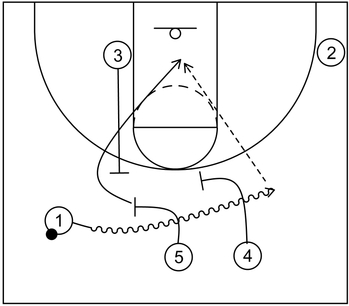
This is an example of double drag screens in addition to the screen the screener Spain action. 1 dribbles toward the right side slot and as that happens, 5 cuts to the basket via the Spain screen set by 3.
After that, 5 could receive the pass from 1 and score near the rim.
Example 10
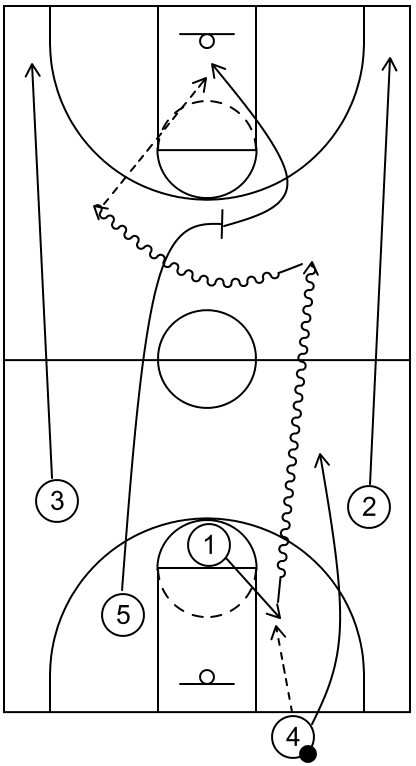
This is an example of the drag screen action within a numbered fast break full court transition. To start, 1 receives the inbound pass from 4 and as that happens, 2 and 3 begin cutting to the corners.
At the same time, 5 begins to cut towards the frontcourt near the top. Following that, 1 dribbles into the frontcourt and uses the drag ball screen set by 5. Afterwards, 5 rolls to the basket and can receive the ball from 1.